August 22, 2025
Video Marketing Strategy Examples to Scale Your Brand Fast
Discover 15+ video marketing strategy examples. Learn what worked, why it worked, and how to apply these proven campaigns to grow your brand.
Every great brand today uses video to stand out. But what makes a video marketing strategy successful? It’s not just about posting a clip on social media. The magic lies in learning from the best video marketing strategy examples.
These campaigns show how video can increase brand awareness, drive conversions, and engage a broader audience across platforms like YouTube, Instagram, and email. From product demos to customer testimonials and creative storytelling, examples reveal what really works.
This guide will show you the most impactful video marketing strategy examples and how to apply them to your own brand.
Key Takeaways
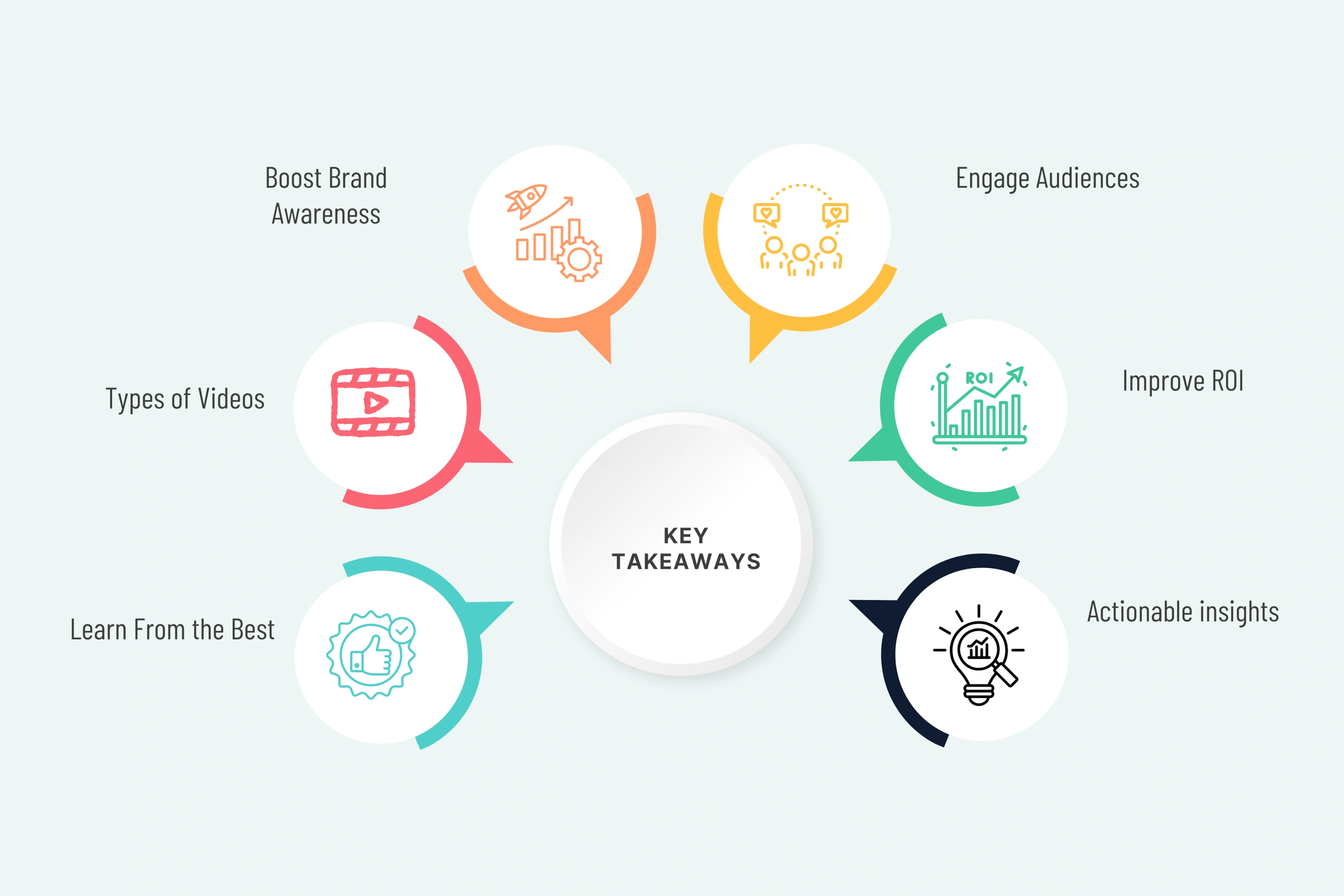
- Learn from the best – See real video marketing strategy examples from global brands.
- Types of videos – Understand how product demos, testimonials, UGC, and explainer videos drive results.
- Boost brand awareness – Discover campaigns that expanded reach and credibility.
- Engage audiences – Learn how short-form ads, cinematic storytelling, and social media videos capture attention.
- Improve ROI – Explore video marketing case studies that show higher conversion rates and measurable results.
- Actionable insights – Apply best practices and creative ideas to your own video marketing efforts.
Why Examples Matter
Looking at real video marketing strategy examples gives more than inspiration — it shows what actually works.

- Spot proven patterns – See how engaging video content and a clear call to action drive results.
- Apply best practices – Learn how leading brands use videos across different platforms to reach a broader audience with quality video.
- Boost marketing ROI – Examples reveal what increases brand awareness, builds credibility, and gets viewers to take action.
- Scale with Unscript – One great idea can turn into multiple versions for testing, localization, and personalization using AI-powered video production.
Best Campaign Examples You Can Learn From
Some of the best video marketing campaigns prove that a strong idea, clear storytelling, and high-quality production can move both hearts and numbers. Here are standout examples:
Reebok — “25,915 Days”
Reebok launched this emotional campaign to remind viewers that the average human life spans just 25,915 days. Instead of focusing on products, the brand tapped into universal urgency—making people rethink how they spend each day and positioning fitness as the pathway to living fully.
What worked here was brand storytelling that transcends the product. It connected fitness to a deeper life philosophy, creating brand awareness and emotional resonance that stuck. The cinematic visuals and pacing made it feel more like a short film than an ad.
Takeaway: If you want a successful video marketing strategy, shift the focus from features to meaning. Use storytelling that makes your audience reflect, not just react.
Heinz — “AI Ketchup”
Heinz tapped into the rising conversation around AI by asking multiple image generators to “draw ketchup.” The fun twist? Most results resembled Heinz bottles, reinforcing their dominance in the ketchup category. By aligning with a trending cultural moment, they created an AI-powered video marketing example that was both timely and memorable.
Why it worked: the campaign combined real-time marketing with humor, while doubling down on Heinz’s brand identity. It felt innovative yet authentic, sparking organic buzz across platforms like YouTube, Instagram, and Twitter. The engaging video content blurred the line between a product demo and social commentary.
Takeaway: Great campaigns don’t just showcase products; they hijack cultural conversations in ways that make the brand feel inevitable. For your next digital marketing video, look at what’s trending and creatively insert your brand.
Coca-Cola — “The Last Customer”
Coca-Cola’s The Last Customer campaign turned the spotlight on small businesses by surprising shopkeepers who were often the “last customers” in their stores after long working days. Instead of a glossy ad, it captured real human stories and generosity, creating UGC-style video marketing examples that felt authentic.
Why it worked: The campaign tied Coca-Cola’s brand to gratitude, community, and celebration. It proved that emotional video marketing can drive stronger connections than polished product videos. It also worked seamlessly across different platforms, from TV spots to videos on social media, reaching a broader audience without losing intimacy.
Takeaway: To establish credibility and increase brand awareness, brands should embrace story-driven video marketing campaigns that show values in action, not just in words.
Coinbase — “QR Code Super Bowl Ad”
Coinbase’s minimalist Super Bowl ad shocked audiences by doing… almost nothing. A colorful QR code bounced around the screen for 60 seconds, leading viewers to a landing page. The simplicity drove curiosity, creating one of the most high-converting video examples in recent ad history.
Why it worked: The ad cut through the noise by breaking the rules of traditional video advertising. Instead of overloading viewers, it tapped into curiosity and the urge to “scan and see.” The result? Massive spikes in web traffic, app downloads, and conversion rates within minutes of airing.
Takeaway: Sometimes, less really is more. An effective video marketing strategy doesn’t always require heavy production. With the right hook, even a low-cost approach can deliver outsized ROI.
Asahi — “Beyond Expected”
Asahi took beer marketing beyond the bottle with its Super Dry Experience. By combining cinematic visuals and immersive storytelling, the campaign turned product consumption into a lifestyle moment. The ad wasn’t just about beer—it was about connecting with modern urban culture and the idea of bold, adventurous living.
Why it worked: It leaned heavily on video storytelling in marketing, showing that beer is not only about taste but also about identity. The sleek production values appealed to younger audiences seeking premium experiences, while also reinforcing Asahi’s global positioning.
Takeaway: Sometimes a product becomes more than a product. By using cinematic video marketing strategies, brands can build culture, not just sales.
Dollar Shave Club — Launch Film
This now-iconic startup ad redefined video marketing best practices for direct-to-consumer (D2C) brands. With humor, raw delivery, and a founder-led script, Dollar Shave Club turned a low-budget video into a viral phenomenon, pulling millions of views and subscribers.
Why it worked: The video blended comedy with clarity, directly addressing pain points (expensive razors) while introducing a product video example that was entertaining and shareable. It proved you don’t need high production budgets—just a bold voice and a clear call to action.
Takeaway: For D2C or e-commerce brands, UGC-style, personality-driven videos can outperform polished corporate campaigns. The key is authenticity and making your marketing video feel like a conversation, not an ad.
ALDI — “Like Brands”
Aldi’s quirky carrot character, Kevin, became a seasonal icon in the UK. Through humor, relatability, and family-friendly storytelling, Aldi turned a supermarket campaign into a cultural event. Each year’s Christmas ad built anticipation, proving that story-driven marketing videos can become long-term brand assets.
Why it worked: Aldi humanized a vegetable and tied it to emotions around family and Christmas. The combination of humor and heart made it one of the most engaging video campaigns, with repeat value across different platforms and even merchandise spin-offs.
Takeaway: Video content creation doesn’t always need celebrities. A strong character and relatable story can fuel brand love year after year.
Google Earth — “Saroo: Homeward Bound”
Google Earth’s “Home” campaign told the story of Saroo Brierley, who used the platform to find his birth family in India after being lost for 25 years. The emotionally charged narrative became one of the most powerful explainer video examples in tech marketing.
Why it worked: This was not a feature demo—it was an epic story of hope and reunion. By showing how a product or service solves real human challenges, Google created one of the best video marketing ROI examples in history, turning tech into something deeply human.
Takeaway: Want to build trust and establish credibility? Anchor your product in a real story where the tech fades into the background and the human story shines.
Spinneys — “The Bread Exam”
Spinneys, a Middle Eastern supermarket chain, partnered with the Lebanese Breast Cancer Foundation to teach women how to self-check for lumps using bread dough as a metaphor. The campaign went viral for its bold creativity and public health impact.
Why it worked: It wasn’t a marketing video about groceries—it was about saving lives. By connecting a supermarket brand with social good, Spinneys cut through the clutter and proved video marketing best practices are not always about sales.
Takeaway: Great campaigns show how a brand can use video content strategy to add value to society, not just to customers.
Hotels.com — “Silent Ad”
Hotels.com leaned into humor with its Captain Obvious character—delivering straightforward, quirky video ads that stuck in memory. Instead of complex storytelling, it used repetition and personality-driven delivery to stand out in a crowded travel market.
Why it worked: The humor, combined with a simple call to action, made these videos highly shareable. They also scaled easily across different platforms and formats, from short-form video ads to full TV spots.
Takeaway: Video campaign strategy doesn’t need to be complicated. A consistent character plus humor can create massive recall at a fraction of traditional costs.
Burberry — “Open Spaces”
Burberry’s Open Spaces campaign combined fashion with surreal video production, showing people running through fields, walking on air, and breaking physical barriers. It was a cinematic masterpiece that blurred the line between advertising and art.
Why it worked: By focusing on engaging videos with high production value, Burberry elevated its brand beyond fashion into cultural imagination. It wasn’t selling coats—it was selling freedom, aspiration, and artistry.
Takeaway: Luxury brands win when they create quality video content that feels timeless, cinematic, and worth revisiting.
Crumbl Cookies — “Sweet Victory”
Crumbl Cookies built a billion-dollar brand largely through videos on social media, especially TikTok. Their weekly product drops became viral moments, with fans reviewing and reacting to new flavors in real time.
Why it worked: They turned their product or service into content fuel. By encouraging user-generated content (UGC) and making customers the marketers, Crumbl achieved what many brands dream of—viral reach at low cost.
Takeaway: If you want to increase brand awareness fast, lean on UGC. Customers can create engaging video marketing content more relatable than polished ads.
Google Android — “Friends Furever”
Google Android’s Friends Furever paired unlikely animal friendships with the tagline “Be together. Not the same.” The heartwarming montage became the most shared ad of 2015.
Why it worked: It used emotional video marketing to position Android as open and inclusive without ever showing the product. The storytelling was simple, universal, and perfect for videos on social media.
Takeaway: Sometimes, the best forms of content are universal emotions like love and friendship. These themes resonate across cultures and different platforms, making them highly shareable.
Netflix — “Fans Make The Movies”
Netflix reminded audiences that every show is more than entertainment—it’s “one story away” from changing how you feel, think, or see the world. This story-driven marketing video tied the brand to inspiration and emotional depth.
Why it worked: Netflix didn’t talk about algorithms or features. It highlighted the power of video storytelling itself, making viewers associate Netflix with personal growth, connection, and discovery.
Takeaway: To resonate with a broader audience, focus on emotions, not features. That’s how you move from being a platform to becoming a cultural icon.
Honda — “The Other Side” (Interactive concept | Dual narrative)
Honda’s legendary Cog ad was a masterpiece in video production best practices. The two-minute Rube Goldberg machine, made entirely of car parts, showed the precision engineering behind Honda vehicles in the most captivating way possible.
Why it worked: It demonstrated product demo videos for brands can be entertaining, not boring. The video showcased engineering credibility while holding viewers’ attention from start to finish.
Takeaway: Want to establish credibility while boosting engagement? Make your product demo so engaging that viewers forget they’re watching marketing.
Category Playbook: Copy These Formats
Not every brand needs to reinvent the wheel. The best video marketing strategies follow proven categories that already work across different platforms and audiences. Here’s a playbook of formats to inspire your own video marketing efforts.
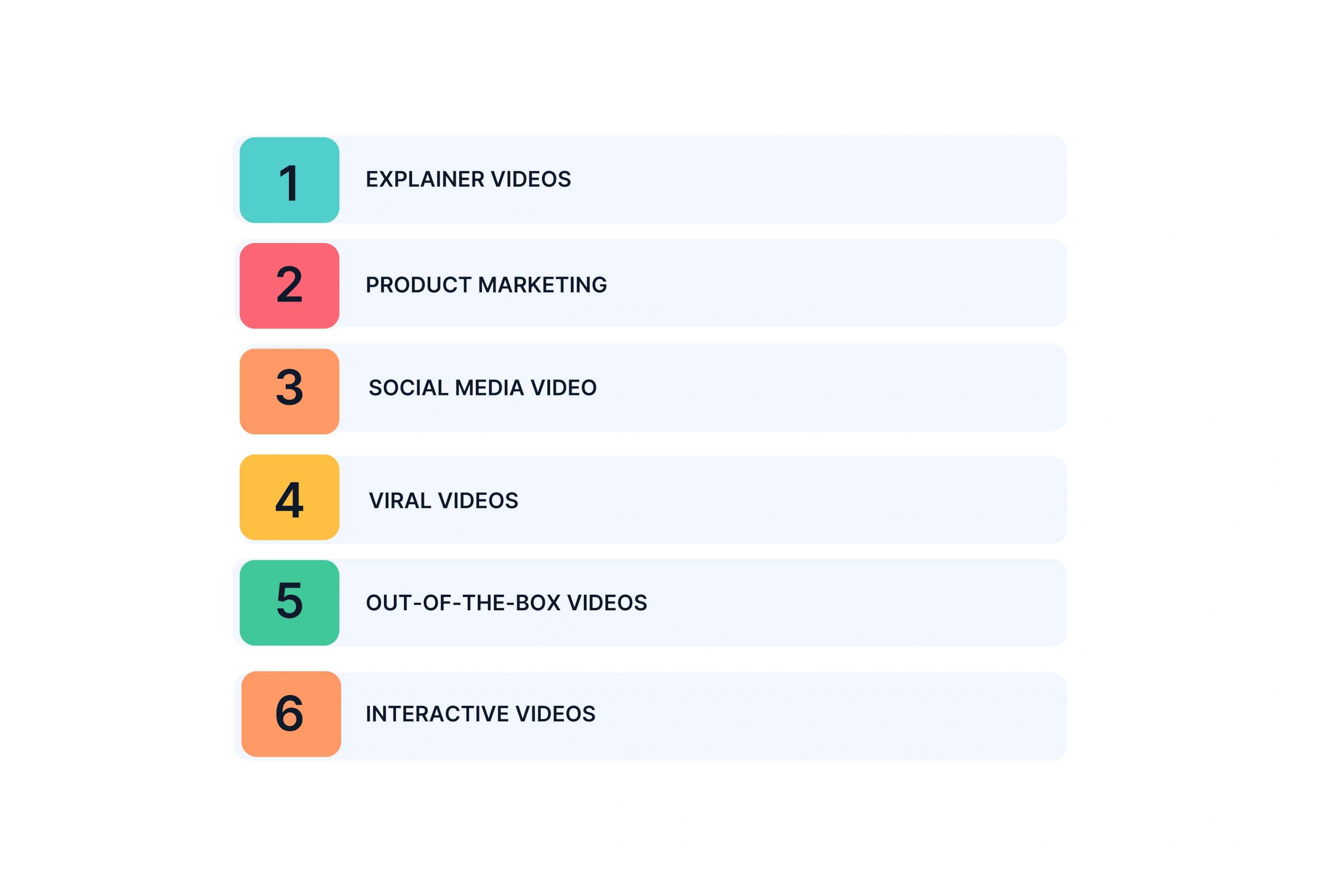
Explainer Video Example
Why it works: Simple problem → clear solution → call to action. Explainers are one of the best practices in video marketing, showing exactly how a product or service solves pain points.
Product Marketing Example
Why it works: Product in action with benefits in plain sight. A marketing video like this boosts conversion rates by letting potential customers see the value first-hand.
Social Media Video Example
Why it works: Fast hook, strong identity, and a clear call to action. Short videos on social media like this help reach a broader audience, increase brand awareness, and keep your brand top-of-mind.
Viral Video Examples
Why they work: Thumb-stopping hooks, humor, and simple offers. These are engaging videos that cut through the noise, leading to increased shares and stronger video marketing ROI.
Out-of-the-Box Examples
Why they work: Surprise and delight that fits the brand. These creative marketing videos prove that sometimes the most engaging content is unexpected—yet perfectly aligned with brand identity.
Interactive Video Examples
Why they work: Real interaction boosts watch time, engagement, and brand recall. Interactive formats show the power of video in creating experiences that stick in memory.
How To Apply These Examples The Unscript Way
Looking at great campaigns is useful, but the real growth comes from applying them at scale. Here’s how to turn inspiration into an effective video marketing strategy using Unscript’s AI-powered approach.
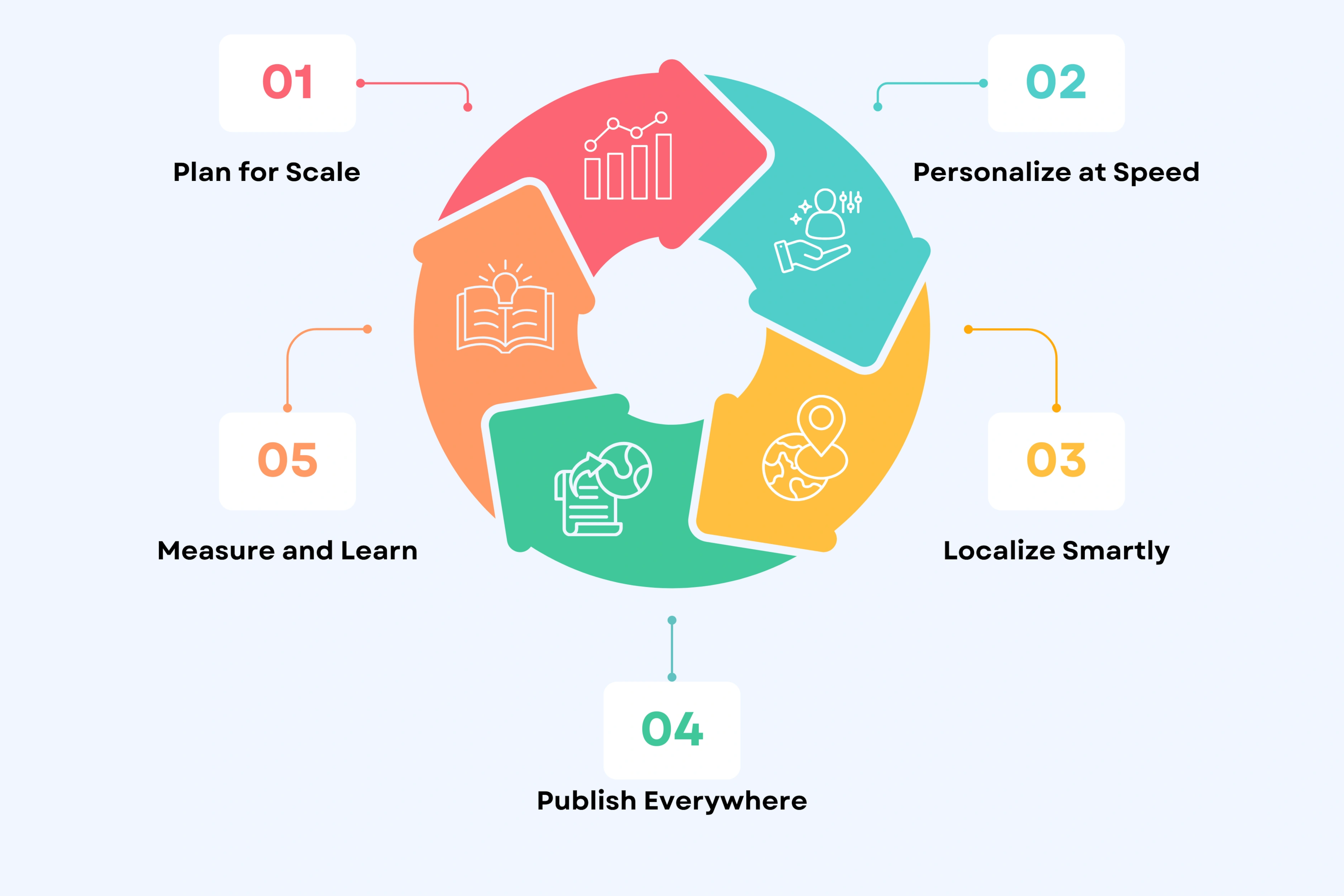
Plan for Scale
One strong concept can multiply into many video ad variations. Run A/B tests, regional cuts, and offer-based edits without re-shoots. This ensures every audience segment gets a message that sticks.
Personalize at Speed
Add names, locations, and custom promos into personalized video marketing campaigns. Make every viewer feel like the content speaks directly to them, leading to increased engagement and stronger conversion rates.
Localize Smartly
Swap languages, subtitles, and visuals in real time. Smart localization of video ads ensures your message lands across markets while keeping costs in check.
Publish Everywhere
Create cutdowns for short-form videos on social media and longer edits for platforms like YouTube. Repurposing means no idea goes to waste, while each platform gets a format built for its audience.
Measure and Learn
Track metrics like click-through rates, conversion rates, and ROI. Double down on winning content and promote it across different platforms for maximum impact.
Where Unscript helps
Unscript powers this process with AI video marketing workflows: scalable video production, lifelike avatars, UGC at scale, and fast turnaround. The result: more engaging videos, less lift, and higher ROI from every campaign.
FAQs
1. What is a video marketing strategy example?
It is a real campaign or case study that shows how brands use video to drive results. Examples include explainer videos, UGC campaigns, and personalized video ads.
2. Why study video marketing strategy examples?
They give proven patterns, help avoid guesswork, and show best practices you can adapt to your own product or service.
3. What are the most effective forms of content in video marketing?
Explainer videos, product demos, short-form social ads, customer testimonial videos, and story-driven brand films are among the best.
4. How do video marketing examples improve ROI?
They highlight what works across different platforms, making it easier to align goals, reduce wasted marketing efforts, and increase conversion rates.
5. Can AI-powered tools help with video marketing?
Yes. AI video production platforms like Unscript help scale creative production, personalize content in real time, and repurpose videos on social media.
6. Which industries benefit most from video marketing strategy examples?
E-commerce, BFSI, D2C, HR, and corporate brands all benefit, as video helps establish credibility, build trust, and reach a broader audience.
7. How do you apply these examples to your brand?
Pick a format that matches your marketing funnel stage, test multiple video ad variations, use video hosting for easy sharing, and track metrics like click-through rates and search engine results.
Conclusion
Video marketing is no longer optional. It is one of the best ways to connect with a broader audience, build brand awareness, and turn potential customers into loyal fans.
From short-form social videos to creative brand storytelling, the right examples show the power of video across platforms like YouTube, Instagram, and email marketing. The key is not just watching what works but applying those insights to your own marketing strategy with high-quality, engaging videos.
Want to create impactful campaigns like these? Schedule a call with Unscript today.


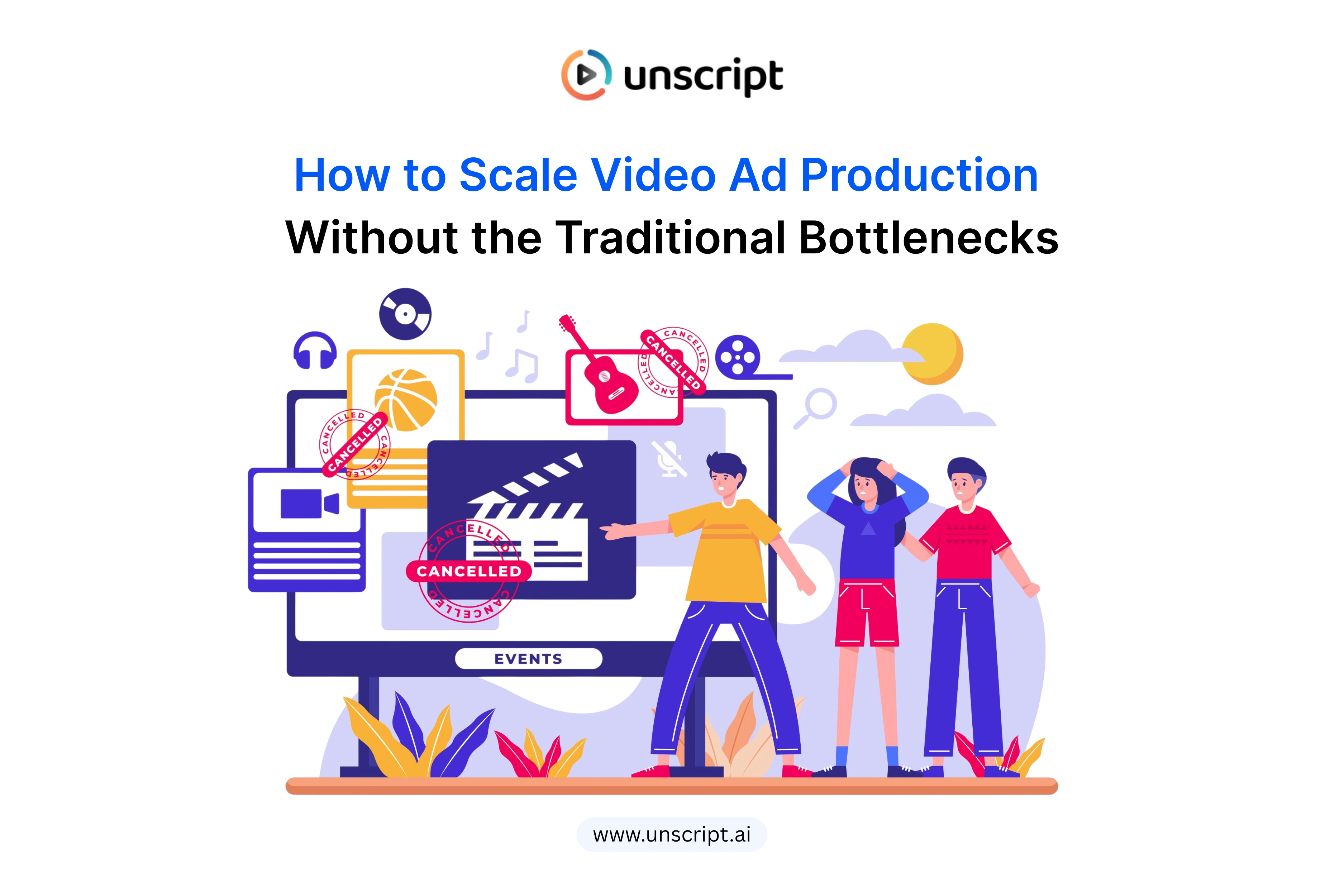
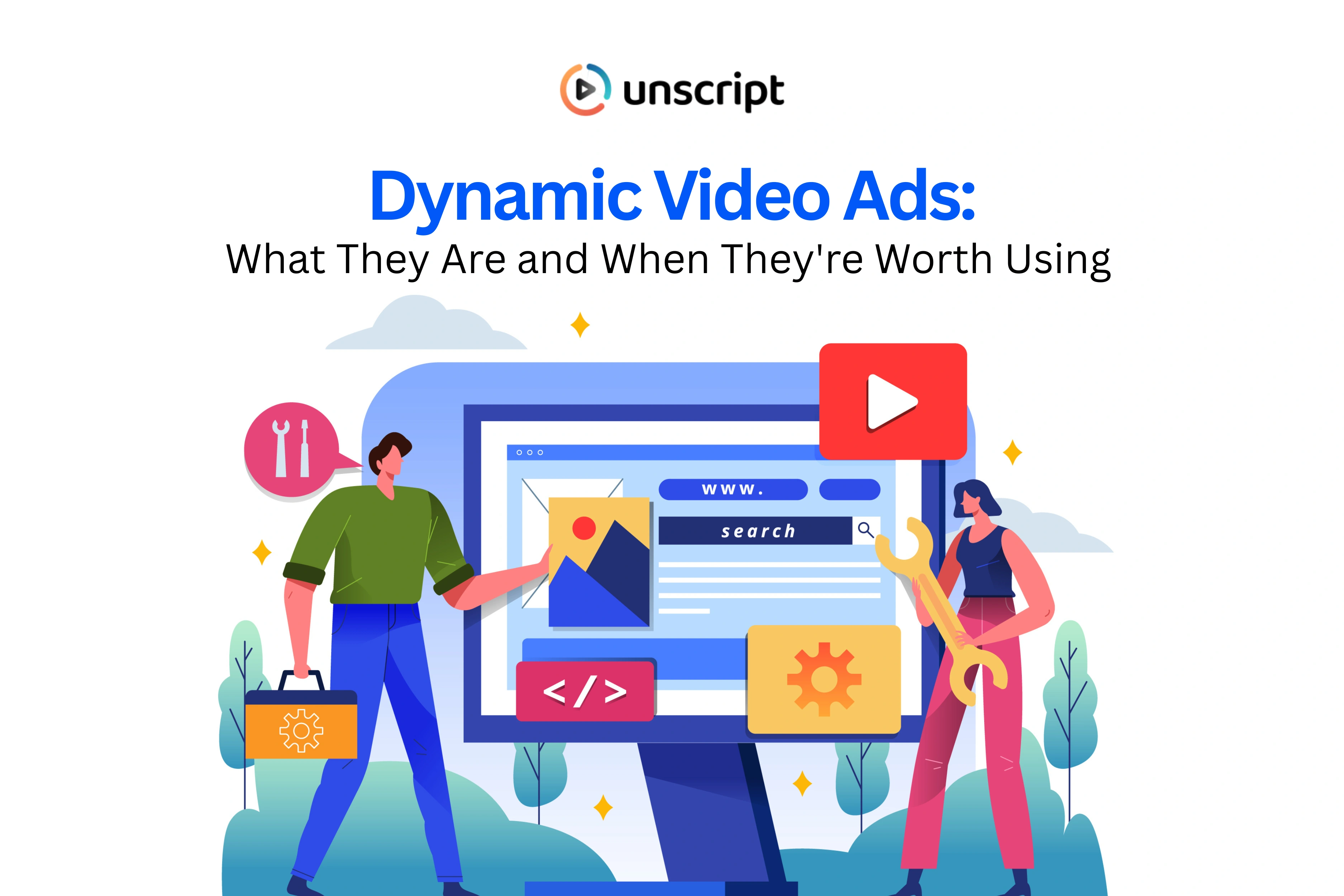
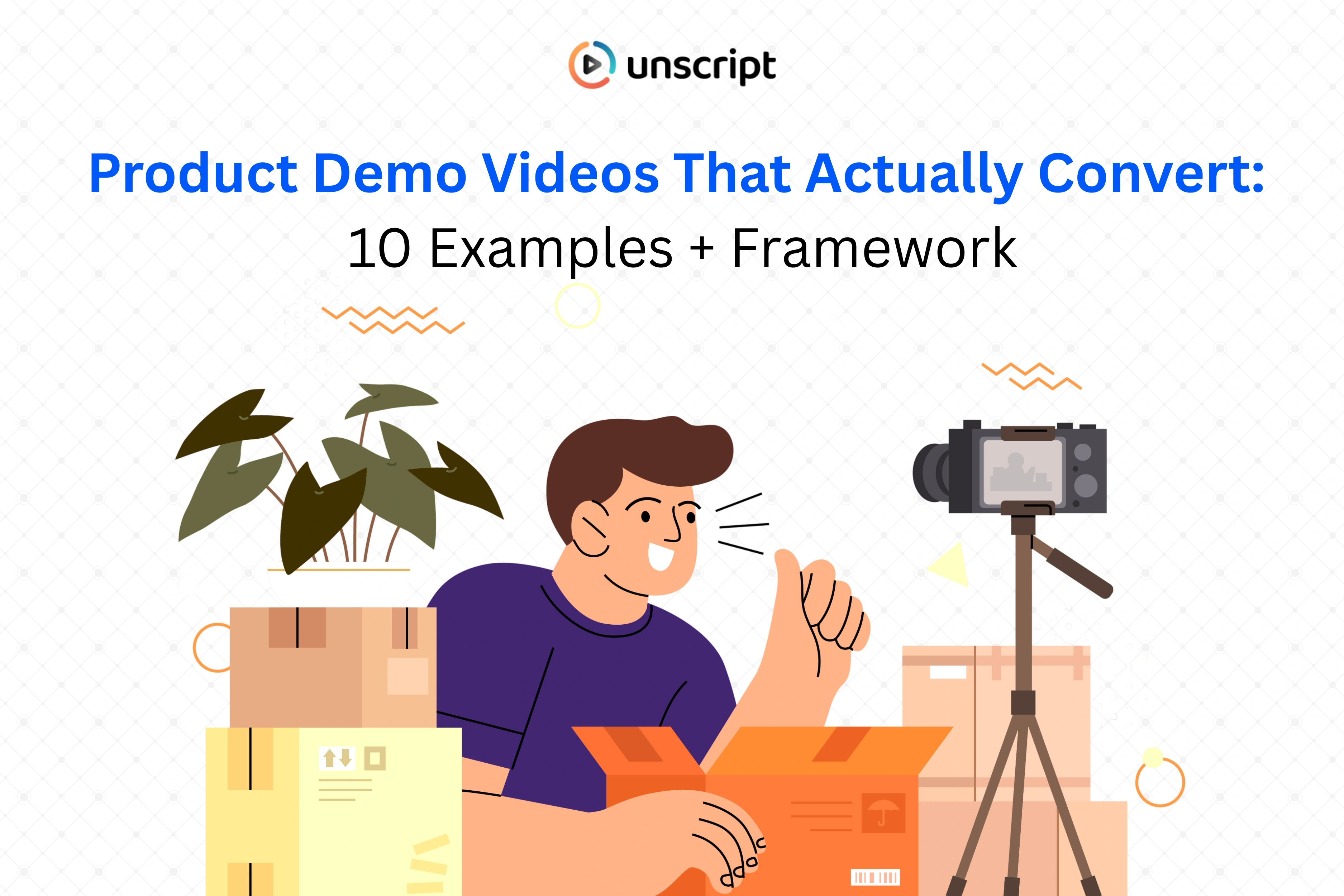










.png)




















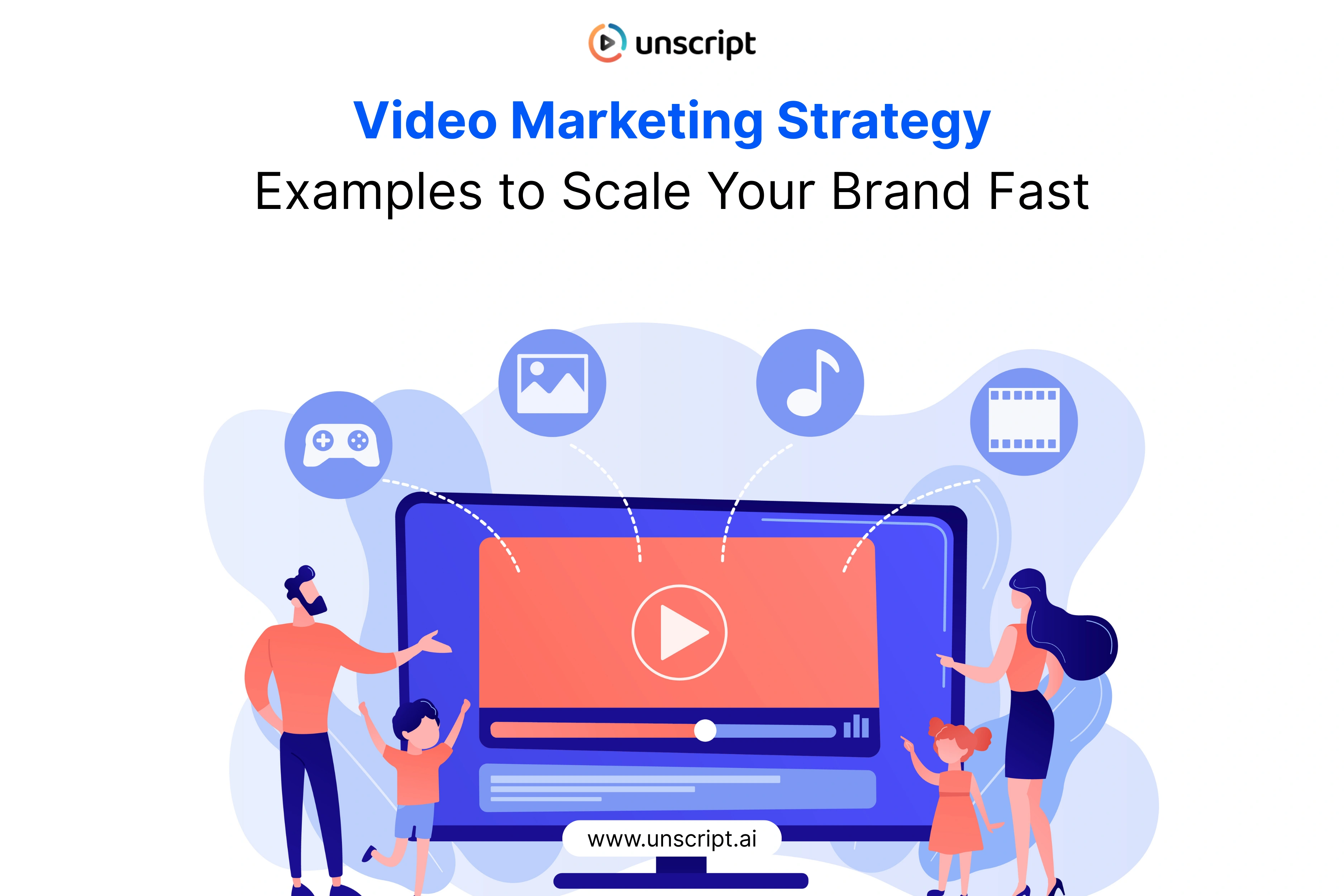
.svg)
.svg)
%201.svg)

.webp)
.webp)





.svg)
